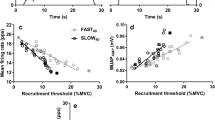Summary
The purpose of this investigation was to determine how the triphasic electromyogram (EMG) pattern of muscle activation developed from the agonist muscle only pattern as movement time (t mov) decreased. Six adult women produced a series of 30° elbow extension movements in the horizontal plane at speeds ranging from ballistic (< 400-ms t mov) to very slow (> 800-ms t mov). Surface EMG from triceps brachii (agonist) and biceps brachii (antagonist) muscles were recorded, together with elbow angle, on a microcomputer. The results showed that triphasic EMG patterns developed systematically as t mov decreased from 1000 ms to < 200 ms. In trials with very long t mov, many elbow extension movements were produced by a single continuous activation of the agonist triceps brachii muscle. As t mov decreased however, agonist activation became predominantly burst-like and other components of the triphasic EMG pattern [activation of the antagonist (Ant) and second agonist activation (Ag2)] began to appear. At the fastest movement speeds, triphasic EMG patterns (Ag1-Ant-Ag2, Ag1 being first activation of agonist muscle) were always present. This data indicated that the triphasic pattern of muscle activation was not switched on when a particular t mov was achieved. Rather, each component systematically developed until all were present, as distinctive bursts of activity, in most trials with t mov less than 400 ms.
Similar content being viewed by others
References
Angel RW (1974) Electromyography during voluntary movement: the two-burst pattern. Electroencephalogr Clin Neurophysiol 36:493–498
Berardelli A, Rothwell JC, Day BL, Kachl T, Marsden CD (1984) Duration of the first agonist EMG burst in ballistic arm movements. Brain Res 304:183–187
Brown SHC, Cooke JD (1981) Amplitude and instruction-dependent modulation of movement-related electromyogram activity in humans. J Physiol 316:97–107
Brown SHC, Cooke JD (1984) Initial agonist burst duration depends on movement duration. Exp Brain Res 55:523–527
Carlyon B (1987) W.A.S.P. technical guide version 2. Department of Anatomy, University of Queensland, St. Lucia 4067, Australia
Garland H, Angel RW (1971) Spinal and supraspinal factors in voluntary movement. Exp Neurol 33:343–350
Ghez C, Gordon J (1987) Trajectory control in targeted force impulses. Exp Brain Res 67:225–240
Hallett M, Marsden CD (1979) Ballistic flexion movements of the human thumb. J Physiol 294:33–50
Hallett M, Smidt GL, Flatt AE, Stephens RI (1975) The influence of wrist position on the force produced by the finger flexors. J Biomech 8:301–306
Lestienne F (1979) Effects if inertial load and velocity on the braking process of voluntary movement. Exp Brain Res 35:407–418
Marsden CD, Obeso JA, Rothwell JC (1983) The function of the antagonist muscle during fast limb movements in man. J Physiol 335:1–13
Meinck H-M, Benecke R, Meyer W, Hohne J, Conrad B (1984) Human ballistic finger flexion: uncoupling of the three-burst pattern. Exp Brain Res 55:127–133
Mustard BE, Lee RG (1987) Relationship between EMG patterns and kinematic properties for flexion movements at the human wrist. Exp Brain Res 66:247–256
Terzuolo CA, Soechting JF, Viviani P (1973) Studies on the control of some simple motor tasks. 1. Relations between parameters of movement and EMG activities. Brain Res 88:233–241
Wallace SA (1981) An impulse timing theory for reciprocal control of muscular activity in rapid, discrete movements. J Mot Behav 13:144–160
Wierzbicka MM, Wiegner AW, Shahani BT (1986) Role of agonist and antagonist muscles in fast arm movements in man. Exp Brain Res 63:331–340
Author information
Authors and Affiliations
Rights and permissions
About this article
Cite this article
Brown, J.M.M., Gilleard, W. Transition from slow to ballistic movement: development of triphasic electromyogram patterns. Eur J Appl Physiol 63, 381–386 (1991). https://doi.org/10.1007/BF00364466
Accepted:
Issue Date:
DOI: https://doi.org/10.1007/BF00364466




